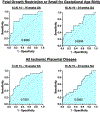Early pregnancy imaging predicts ischemic placental disease
- PMID: 37549442
- PMCID: PMC11090111
- DOI: 10.1016/j.placenta.2023.07.297
Early pregnancy imaging predicts ischemic placental disease
Abstract
Introduction: To characterize early-gestation changes in placental structure, perfusion, and oxygenation in the context of ischemic placental disease (IPD) as a composite outcome and in individual sub-groups.
Methods: In a single-center prospective cohort study, 199 women were recruited from antenatal clinics between February 2017 and February 2019. Maternal magnetic resonance imaging (MRI) studies of the placenta were temporally conducted at two timepoints: 14-16 weeks gestational age (GA) and 19-24 weeks GA. The pregnancy was monitored via four additional study visits, including at delivery. Placental volume, perfusion, and oxygenation were assessed at both MRI timepoints. The primary outcome was defined as pregnancy complicated by IPD, with group assignment confirmed after delivery.
Results: In early gestation, mothers with IPD who subsequently developed fetal growth restriction (FGR) and/or delivered small-for gestational age (SGA) infants showed significantly decreased MRI indices of placental volume, perfusion, and oxygenation compared to controls. The prediction of FGR or SGA by multiple logistic regression using placental volume, perfusion, and oxygenation revealed receiver operator characteristic curves with areas under the curve of 0.81 (Positive predictive value (PPV) = 0.84, negative predictive value (NPV) = 0.75) at 14-16 weeks GA and 0.66 (PPV = 0.78, NPV = 0.60) at 19-24 weeks GA.
Discussion: MRI indices showing decreased placental volume, perfusion and oxygenation in early pregnancy were associated with subsequent onset of IPD, with the greatest deviation evident in subjects with FGR and/or SGA. These early-gestation MRI changes may be predictive of the subsequent development of FGR and/or SGA.
Trial registration: ClinicalTrials.gov NCT02786420.
Keywords: Ischemic placental disease; Oxygenation; Perfusion; Placental blood flow.
Copyright © 2023 The Authors. Published by Elsevier Ltd.. All rights reserved.
Conflict of interest statement
Declaration of competing interest None of the authors have any conflict of interest.
Figures




References
Publication types
MeSH terms
Associated data
Grants and funding
LinkOut - more resources
Full Text Sources
Medical
Miscellaneous

